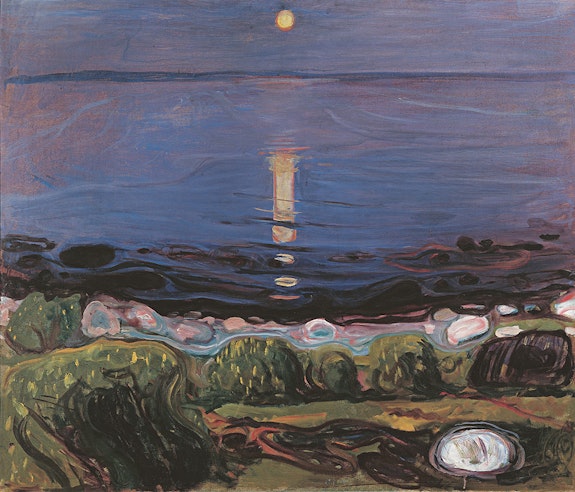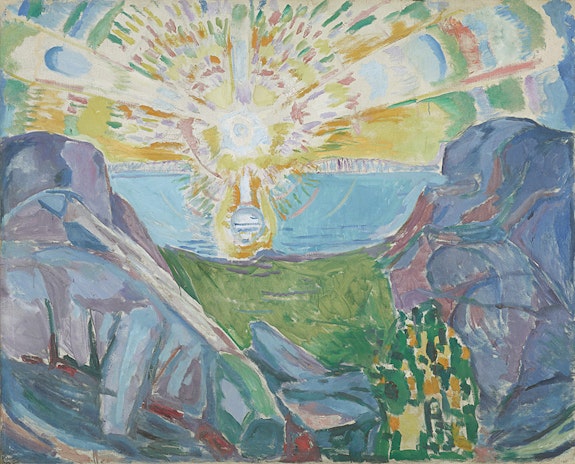ArtSeen
Edvard Munch: Trembling Earth

On View
Trembling EarthClark Art Institute
June 10–October 15, 2023
Williamstown, Massachusetts
November 18, 2023–April 1, 2024
Potsdam, Germany
April 27–August 24, 2024
Oslo, Norway
This retrospective includes over seventy-five objects, with drawings, prints, and many large paintings providing an overview of Edvard Munch’s long career. Born in 1863, and so a near-contemporary of the French Post-Impressionists, he outlived them all, working prolifically until 1944. As its title, Trembling Earth signals, the exhibition is focused on his images of nature. That title is taken from the drawing The Human Being and its Three Power Centers (1930), displayed in the exhibition. For Munch, humanity is interconnected with the universe in an energy flow that he called “earth waves,” or “trembling earth.” The show is installed in the spacious, Tadao Ando designed temporary exhibition galleries, where dark walls enhance the effect of Munch’s colors.
Trembling Earth is organized in terms of categories of landscapes. Thus the first section, “In the Forest,” opens with The Yellow Log (1912), showing the destruction of the Norwegian forests by the logging industry. And then The Magic Forest (1919–25) presents the landscape as a place of fantasy. Here, as in the later sections, the paintings are frequently supplemented by Munch’s imagery of human responses to these sites. “Cultivated Landscape” thus includes Fertility (1899–1900), showing a man and woman gathering apples from a tree, and The Haymaker (1917) depicts a workman with a scythe. And, also, there is a very strange late picture, Self-Portrait by the Arbour (1942). Next, “On the Shore” includes the magical Moonlight (1895), with the moon reflected in the waters; the extraordinary Beach (1904), a beach painted in colors like those that would be regularly chosen by Renoir; and Separation (1896), with the man and woman set apart from one another on the beach. And then this plan continues with sections devoted to “Chosen Places,” “The Scream of Nature,” “Snow and Storm,” and “In a Cosmic Cycle.” Of most interest in the last of these sections is The Sun (1912), an image of the sun’s radiance which anticipates the abstractions drawn from nature of another Scandinavian artist, Hilma af Klint.

Nature tends to scream for Munch. Calm aesthetic contemplation was alien to his personality. You need only take the short walk from this new wing of the Clark Art Institute to the older beaux-arts building, which houses the main Clark galleries, to see that Munch’s landscapes are unlike other early modernists, who are well represented in this permanent collection. However much he learned on his early visit, in 1889, to Paris from Camille Pissarro, Vincent van Gogh, and the Impressionists, he has more in common with the Danish artist Per Kirkeby (1938–2018). A very gifted provincial, not as polished as van Gogh, Munch retained a certain rustic roughness, which can be immensely attractive in small doses. Indeed, had he remained in France or Berlin, perhaps he would have been less original; relative isolation in Norway may have been liberating.

Munch’s extreme high-pitched color and his painterly brushwork look towards some artworks of Abstract Expressionists. I would love to see some of his landscapes displayed next to works by Joan Mitchell and Willem de Kooning, for in them Munch leaves behind his drearily predictable view of human relations, one source of the repetitions of his figurative compositions. Look at Waves (1908), moving towards radical abstraction. Or the grouping of trees in Thawing Snow (1919) and the intense blue landscape in Winter Night (1923), with the bare tree not unlike that in some early Mondrians. These paintings are boldly original. And, as I mentioned, The Sun is a very ambitious, seemingly unprecedented creation. By contrast, Munch’s various male and female nudes are no match for those of Ernst Ludwig Kirchner and his other German peers. Munch is famous in this country, but known for just a few images. And so the curatorial idea to focus on his view of nature was very good. Where does Munch fit in the history of expressionist landscape painting? And how do his views of ecology differ from ours? Those questions remain to be fully answered. But this eye-catching show is a great beginning.
-
Note:
-
The catalogue Edvard Munch. Trembling Earth (MUNCH, 2023) has essays on his ecological concerns. On his life, I have learned from Sue Prideaux, Edvard Munch. Behind the Scream (New Haven, 2003). And I thank Carolynn McCormack, Communications Manager at the Clark, for spelling out the meaning of the exhibition’s title.

